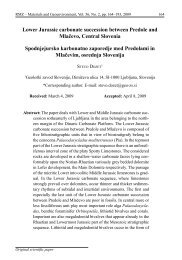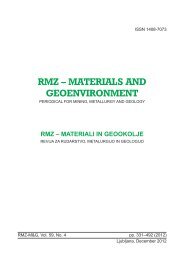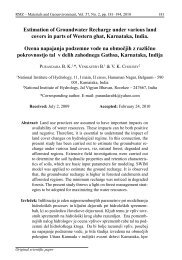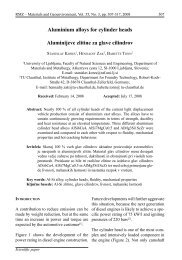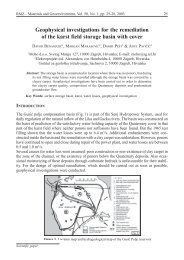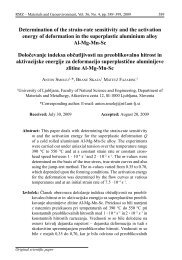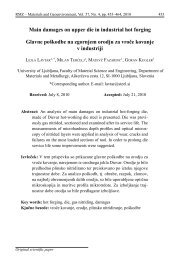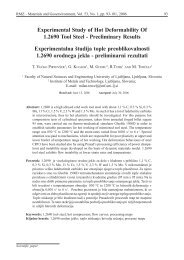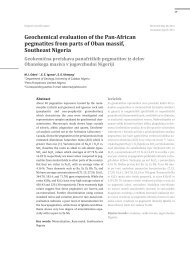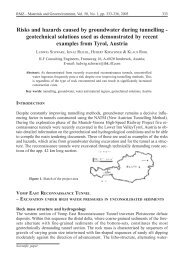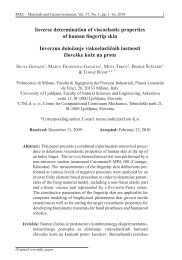Durability evaluation of some Slovenian building limestones ... - RMZ
Durability evaluation of some Slovenian building limestones ... - RMZ
Durability evaluation of some Slovenian building limestones ... - RMZ
Create successful ePaper yourself
Turn your PDF publications into a flip-book with our unique Google optimized e-Paper software.
<strong>Durability</strong> <strong>evaluation</strong> <strong>of</strong> <strong>some</strong> <strong>Slovenian</strong> <strong>building</strong> <strong>limestones</strong><br />
335<br />
their damaging effect. After the frost<br />
resistance test, limestone loss <strong>of</strong> mass<br />
Vb48 was determined. Changes in microstructure<br />
were observed using SEM-<br />
EDX and USV after 15 immersions in<br />
Na-sulphate and 48 freeze-thaw cycles.<br />
Cross-sections <strong>of</strong> the weathered limestone<br />
samples were examined under a<br />
Scanning Electron Microscope (JEOL<br />
5600 LV), using the low vacuum backscattered<br />
electrons (BSE) imaging<br />
mode. Some areas <strong>of</strong> the samples were<br />
analysed for chemical composition using<br />
the energy dispersive X-ray technique<br />
(EDS).<br />
In order to determine changes in the<br />
mechanical-physical properties <strong>of</strong> the<br />
samples after the ageing procedures<br />
were carried out, ultrasonic velocity<br />
measurements were performed in three<br />
directions using an AU 2000 Ultrasonic<br />
Tester (CEBTP) with a transmission<br />
frequency <strong>of</strong> 60 kHz. Speed <strong>of</strong> sound<br />
wave propagation was undertaken according<br />
to standard procedure EN<br />
14579. Three measurements were performed<br />
in each <strong>of</strong> the three orthogonal<br />
directions. Additionally, the total structural<br />
anisotropy coefficient ΔM/% and<br />
relative anisotropy coefficient Δm/%<br />
<strong>of</strong> the samples were obtained from the<br />
mathematical relationship between the<br />
ultrasonic propagation velocities, following<br />
the equations <strong>of</strong> Guydader &<br />
Denis (1986):<br />
a) total anisotropy:<br />
ΔM/% = 100 [1 – (2 V L1<br />
/V L2<br />
+ V L3<br />
)] (1)<br />
b) relative anisotropy:<br />
Δ m% = 100 [2 (V L2<br />
- V L3<br />
)/V L2<br />
+ V L3<br />
] (2)<br />
where V L1<br />
is the lowest and V L2<br />
the<br />
highest measured velocity.<br />
The degree <strong>of</strong> weathering can be calculated<br />
through the reduction <strong>of</strong> longitudinal<br />
wave velocity (Zezza & Veinale,<br />
1988) from unweathered (V 0<br />
) to weathered<br />
(V w<br />
) stone samples:<br />
K = (V 0<br />
- V w<br />
)/V 0<br />
or ΔV(L)% =<br />
100 (V 0<br />
- V w<br />
)/V 0<br />
(3)<br />
USV measurements were carried out<br />
both before and after the salt crystallisation<br />
(on unwashed and washed specimens)<br />
and frost resistance tests.<br />
Results and discussion<br />
Splitting tensile strength<br />
As can be seen from Table 1, all three<br />
<strong>limestones</strong> exhibited high values <strong>of</strong><br />
splitting tensile strength, although levels<br />
slightly differed between each one.<br />
The highest strength was observed in<br />
the grey lithotype <strong>of</strong> the Lesno Brdo<br />
limestone, followed by Drenov Grič<br />
limestone and the red Lesno Brdo<br />
lithotype. There were no significant<br />
differences observed between the different<br />
orientations <strong>of</strong> bedding planes<br />
<strong>RMZ</strong>-M&G 2010, 57



